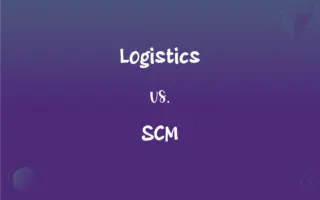WLL vs. SWL: What's the Difference?
Edited by Harlon Moss || By Janet White || Published on February 3, 2024
WLL (Working Load Limit) is the maximum safe force that a piece of lifting equipment can handle, while SWL (Safe Working Load) is the older term for the same concept, often replaced by WLL.

Key Differences
WLL, or Working Load Limit, is a specific term used in the field of rigging and lifting, referring to the maximum load that equipment such as slings, chains, or hoists can safely handle under normal conditions. It is a crucial safety measure. SWL, or Safe Working Load, is an older term that essentially meant the same thing but has been largely replaced by WLL in many standards and practices. Both terms are critical for ensuring the safety and integrity of lifting operations.
The WLL is determined by the manufacturer and takes into account the strength of the material, design factors, and the type of load. It is essential for users to adhere to the WLL to prevent equipment failure and accidents. In contrast, SWL was traditionally calculated as the breaking strength of a component divided by a safety factor, usually determined by industry standards or regulations. Although SWL is still used in some contexts, WLL is more commonly seen in modern industry standards.
In practice, WLL is used to label equipment, ensuring users are aware of the limits of their gear. This helps in selecting the right equipment for specific lifting tasks. SWL was used similarly but has been phased out in favor of WLL in many industries, as WLL provides a clearer indication of the safe limit of equipment use.
WLL values are critical for safety in industries like construction, shipping, and engineering, where heavy lifting is commonplace. It is a key factor in risk assessment and safety planning. On the other hand, SWL served the same purpose in the past and can still be found in older equipment or in certain regions where industry practices have not shifted to the newer terminology.
Both WLL and SWL are vital for the safe operation of lifting equipment. They help prevent overloading and potential accidents. While WLL is the more current and widely accepted term, understanding both is important for professionals in industries involving lifting and rigging operations.
ADVERTISEMENT
Comparison Chart
Definition
Maximum load that equipment can safely handle.
Older term for the maximum safe load limit.
Usage
More current and widely used in industry standards.
Older term, still used but less common.
Determination
Set by manufacturer considering various factors.
Traditionally calculated with a safety factor.
Industry Adoption
Predominantly used in modern practices.
Found in older practices and some regions.
Importance
Essential for safety in lifting operations.
Historically important for equipment safety.
ADVERTISEMENT
WLL and SWL Definitions
WLL
Manufacturer's Limit.
Check the WLL before use.
SWL
Load Handling Guideline.
The SWL is marked on the equipment.
WLL
Load Capacity Indicator.
Each chain is marked with its WLL.
SWL
Safe Load Capacity.
The SWL of this hoist is 5 tons.
WLL
Maximum Safe Load.
The crane's WLL is 10 tons.
SWL
Equipment Load Limit.
Always observe the SWL for safety.
WLL
Safety Standard.
Adhering to the WLL prevents accidents.
SWL
Load Limit Reference.
This older gear still uses SWL labels.
WLL
Lifting Equipment Rating.
The WLL ensures safe operation.
SWL
Safety Calculation Basis.
SWL was determined using safety factors.
FAQs
Is WLL the same as SWL?
Essentially, but WLL is the more modern term.
What does SWL stand for?
Safe Working Load.
What does WLL stand for?
Working Load Limit.
Why is WLL used instead of SWL?
WLL provides clearer, standardized safety guidelines.
Is SWL still used in the industry?
Less commonly, as WLL has become more prevalent.
Can WLL change over time?
It can, due to wear or damage to the equipment.
How should I select equipment based on WLL?
Choose equipment with a WLL above your maximum load.
Do WLL and SWL apply to all types of lifting gear?
Yes, they apply to all lifting and rigging equipment.
Can WLL and SWL values differ?
They typically represent the same load limit.
How is WLL determined?
By the manufacturer based on design and material strength.
Does SWL include a safety factor?
Traditionally, SWL was calculated with a safety factor.
Is WLL mandatory on all lifting equipment?
Yes, for safety and regulatory compliance.
Are WLL and SWL important for safety?
Yes, they are critical for safe lifting operations.
Can I exceed the WLL or SWL?
No, exceeding these limits can lead to accidents.
Should I regularly check WLL markings?
Yes, regular checks ensure ongoing safety.
How do I know if equipment has a valid WLL?
Look for manufacturer’s markings and certification.
What happens if WLL or SWL is not followed?
It can lead to equipment failure and accidents.
Are WLL and SWL regulated by law?
They are part of safety regulations in many jurisdictions.
Can WLL be increased through maintenance?
No, WLL is set based on design and cannot be increased.
Do training programs cover WLL and SWL?
Yes, proper understanding of these terms is crucial in training.
About Author
Written by
Janet WhiteJanet White has been an esteemed writer and blogger for Difference Wiki. Holding a Master's degree in Science and Medical Journalism from the prestigious Boston University, she has consistently demonstrated her expertise and passion for her field. When she's not immersed in her work, Janet relishes her time exercising, delving into a good book, and cherishing moments with friends and family.
Edited by
Harlon MossHarlon is a seasoned quality moderator and accomplished content writer for Difference Wiki. An alumnus of the prestigious University of California, he earned his degree in Computer Science. Leveraging his academic background, Harlon brings a meticulous and informed perspective to his work, ensuring content accuracy and excellence.







































































